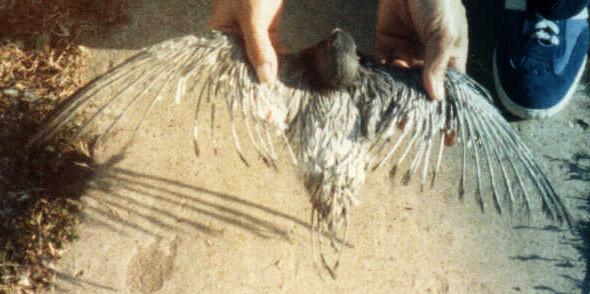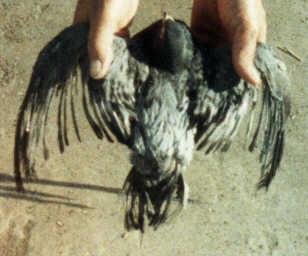pigeons
My "Porcupine" Pigeons
By Robert J. Mangile
American Pigeon Journal
December 1984, page 16.
Of the various plumage structures in pigeons under genetic control, the quill-like feather condition named "porcupine" by Cole and Hawkins in 1930, is perhaps the most bizarre. Simply stated, each feather resembles the quill of a porcupine. This appearance is a result of the feathers' failure to unsheath.

Porcupine pigeon in juvenile plumage -- Photo from Robert J. Mangile
In 1980, a pair of my tiger-grizzled Racing Homers, a paternal half-brother--half-sister mating, produced a single squab that appeared weak at hatching. It struggled until about two weeks of age when it became apparent that its feathers were quill-like; but its general condition seemed to improve. Eventually, it matured as a blue check porcupine hen. I mated her to a blue barred normal plumaged cock and got eight perfectly normal-plumaged offspring, in check and bar patterns and of both sexes. Sons backcrossed to porcupine Mother and brother-sister matings produced both normal and porcupine plumages, but only a few porcupine young lived to maturity.
New porcupine squabs appear wet and rough. with a coarse feeling to the touch. Pigeon milk is ingested later and in lesser amounts than normal squabs. Those not receiving milk soon after hatching seldom survive the second or third day. During the first week they seem unable to ingest normal amounts of milk. Full crop size is about one-third of normal size, hard to the touch and offers little resistance to pressure applied from ones finger. The skin appears crusty and the entire general body appears to be restricted in movement. Normal nestmates usually outgrew the porcupines and were often moved to foster parents to eliminate competition.
There seem to be two critical stages in porcupines early development; first, is whether or not they receive pigeon milk soon after hatching, and second, at about ten days of age, despite their struggling condition, they appear to be growing more stable and begin taking on the appearance of normal squabs.
During pin-feather stage the folded wing-end. from the wing-butt to the wing-tip has a flipper-like appearance, resembling the front legs (flippers) of some sea turtles. Perhaps twice or three times larger than normal, this flipper-like wing-end is produced by a thickening of the fleshy portions of the wing-end.
The eyelids seem to be tight and in some birds have difficulty in closing. One case was very pronounced with upper lids drawn well back and could not be induced to close by touching the eyeballs. Flies gathered around the constantly open eyes at the age when parents leave squabs uncovered. This condition disappears before weaning time.
In Levi's "The Pigeon" pages 328-329 porcupine and other plumage abnormalities are discussed, including "Scraggly" which has crusty skin. My porcupine squabs have a dehydrated appearance and their skin is crusty and flaky, like the description of "scraggly" squabs. With that thought I used a syringe and a small tube to administer water into crops of porcupine squabs as early as possible, but cannot claim that it does in fact help their survival. Beyond two weeks of age they progress normally. Perhaps due to a larger body volume which enables more water retention; also, parents usually leave squabs uncovered more and provide less heat to dry out squabs.
Squeakers behave normally and fend for themselves without difficulty, except they are unable to fly. At weaning time the porcupine-like feathers are most extreme. With successive molts the contour feathers seem to gradually become more normal. A four-year-old porcupine hen appears to be 75% normal, with respect to contour feathers and clearly displays a checkered pattern. The rectrices and primary flights aren't changed much but the secondary flights appear to be less quill-like than in the juvenile plumage. Adult porcupines breed fairly well, but need added protection from wet and severe cold weather? In Kansas, where sub-zero temperatures are not uncommon, my porcupines have survived well in unheated buildings.

The
original Porcupine four year old hen referred to in the accompanying article.
Photo from Robert J. Mangile
I claim that I have the best porcupine pigeons in the
World; and they are probably more useful than any prize-winning breed or
strain. If you think I'm crazy h'mm, who ain't?